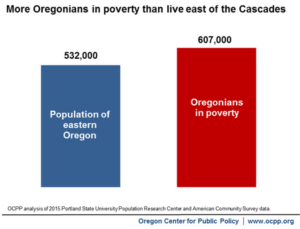News Release
Oregon’s poverty rate declined and the income of the typical Oregon household jumped last year, but not enough to return to pre-recession levels. That is according to the Oregon Center for Public Policy’s analysis of U.S. Census data released today.
“Even with these big improvements, too many Oregonians still cannot make ends meet through no fault of their own,” said Center analyst Tyler Mac Innis. “We still need to take steps to make sure that everyone in our state has the opportunity to build a secure future.”
In 2015, Oregon median household income — the income of the household in the middle of the income ladder — increased by about $3,000 to $54,150 from the year before. That was the highest level since 2008, adjusting for inflation, according to the Center.
“This is good news for sure, but it’s important to put it in perspective,” Mac Innis said. He noted that for over three decades, Oregon’s median household income has stagnated.

The poverty rate in Oregon dropped to 15.4 in 2015, Census data showed, a decline of 1.2 percentage points from the prior year. By comparison, the poverty rate in Oregon stood at 12.9 percent in 2007, before the start of the Great Recession.
Child poverty, however, remained stubbornly elevated. The poverty rate for children in 2015 was not statistically different from 2014. About 1 in every 5 Oregon children lived in poverty in 2015.
Even with the sharp drop in the overall poverty rate, there were 607,000 Oregonians living in poverty in 2015. “That’s more people than all the Oregonians who live east of the Cascades,” said Mac Innis. “And bear in mind, the official definition of poverty sets the bar too low — it significantly understates what it takes to meet basic needs today.”
Oregon also saw improvements in the share of seniors in poverty. Senior poverty fell from 8.8 to 7.3 percent, said Mac Innis.
And the poverty rate also declined for many communities of color, although as a whole communities of color are still more likely to live in poverty than non-Hispanic white Oregonians. Black Oregonians were most likely to live in poverty. Nearly one in every three black Oregonians lived below the poverty line in 2015, compared to about one in every eight non-Hispanic white Oregonians.
“While the picture has improved, the reality is that the economy is still not working well for everyone,” Mac Innis said. “This affects us all. We are a stronger and more prosperous state when everyone has an opportunity to get ahead.”
The Oregon Center for Public Policy (www.www.ocpp.org) is a non-partisan, non-profit institute that does in-depth research and analysis on budget, tax and economic issues. The Center’s goal is to improve decision making and generate more opportunities for all Oregonians.








